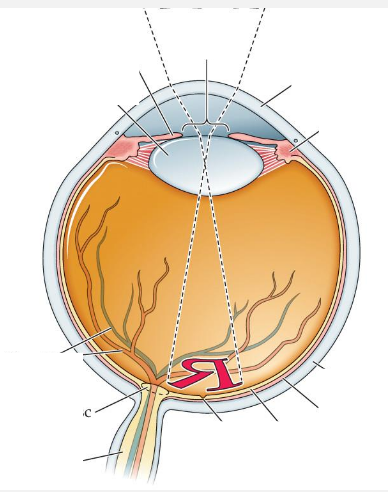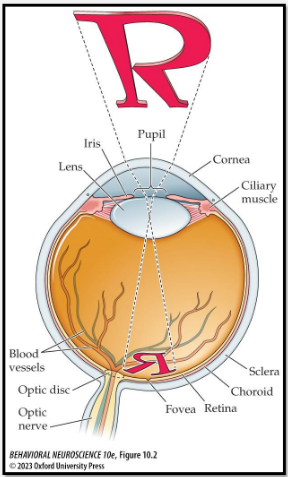Lecture 7 - Sensation and perception
1/75
There's no tags or description
Looks like no tags are added yet.
Name | Mastery | Learn | Test | Matching | Spaced |
|---|
No study sessions yet.
76 Terms
what is significant about the stretch reflex circuit?
the strength of the stimulus determines the strength of the response
what is signal divergence
when one neuron sends its signal to multiple other neurons or target cells
what is signal convergence
when many neurons synapse onto a single neuron, which integrates different types of information
what are sensory modalities?
Sensory modalities are the different kinds of senses or types of sensory experiences your body can detect. Each modality refers to a distinct way your nervous system picks up information about the world or your body.
what are some examples of sensory modalities?
vision
smell
taste
touch
thermal sense
pain
hearing
balance
proprioception
what is transduction in sensory and perception
conversion of physical energy from a stimulus into a change in membrane potential in a receptor cell
what are transducers?
receptor cells
what are receptor potentials
local changes in membrane potential
what type of energy do all of the senses use to communicate with the brain?
APs
describe how sensory information processes
each sensory system has a distinct sensory pathway in the brain and passes through stations during processing
where do most sensory pathways pass through?
the thalamus
where does sensory pathways terminate in the brain
cerebral cortex
what is psychophysics
An investigation of the relationship between physical stimuli, sensation, and perception
what is the typical relationship in psychophysics
stronger stimulus → evokes more APs
stronger stimulus → perceived as stronger
what is generator potential
A local, graded electrical change that happens in a sensory receptor cell when it detects a stimulus (like light, pressure, or vibration).
what is the difference between generator potential and action potential
generator potential
graded, local
varies with stimulus
action potential
all-or-non,
does not vary with stimulus, same strength at all times
what is contrast sensitivity
ability to detect differences in light and dark (contrast) between parts of an image or scene.
what are the low level processing of vision
contrast
colour
disparity
orientation
movement direction
what is contrast
the difference in brightness or color that makes an object stand out from its background.
what is colour
Colour is how your brain interprets different wavelengths of light.
what is disparity
the slight difference between what your left and right eyes see — it’s key for depth perception (stereopsis).
what is orientation
Orientation is the angle or tilt of edges, lines, or patterns.
what is movement direction
This is your ability to see which way something is moving.
what are the intermediate level of visual processing
contour integration
shape discrimination
surface properties
object motion / shape from kinetic cues
surface depth
what is contour integration
This is the brain’s ability to connect separate edge or line segments into a continuous boundary or contour.
what is shape discrimination
The ability to tell apart or recognize different shapes.
what is surface properties
Attributes like texture, color, glossiness, or shading that help identify what a surface is made of.
what is object motion / shape from kinetic cues
Using movement to perceive the 3D structure of an object.
what is surface depth
The perception of how near or far a surface is in 3D space.
what is bottom up processing
perception starts with the raw sensory input, and the brain builds up a mental image step by step from that input — without prior knowledge
what is top down processing
when your brain uses prior knowledge, expectations, context, or experience to interpret and make sense of incoming sensory information.
Describe how visual perception is a constructive process.
Combining raw data with prior knowledge:
The brain uses incoming visual signals and what you already know, expect, or assume, to build what you “see.”Filling in gaps:
Your brain completes missing parts of objects and scenes (e.g., you still perceive a whole object when it’s partially hidden).Resolving ambiguity:
It chooses the most likely interpretation when visual input is unclear or conflicting (e.g., optical illusions show this).Using context:
Surrounding cues help determine colors, depth, shapes, and motion — your brain adjusts how you see things based on context.
what is light
a band of electromagnetic radiation; comes in packets of energy called quanta
what is wavelength
distance between two adjacent crests of vibratory activity
what are photons
human visual system responds only to quanta of wavelengths between 400 - 700 nm; quanta in this range are called photons

label the eye

what is refraction
bending of light rays
how is refraction done in the eye
bending of light rays — done by the cornea and lens to form the image on the retina
what is accomodation in terms of the eye
Accommodation is the process by which the ciliary muslces of the eye changes its shape to focus on objects at different distances.
what is the role of the pupil
control the amount of light entering the eye by controlling the iris
what controls pupil dilation
Sympathetic nervous system
what controls pupil constriction
parasympathetic nervous system
what controls eye movement
extraocular muscles
what does the nuclear layers contain
cell bodies/nuclei of retinal neurons
what does the plexiform layers contain
synapses and axons
how the structure (anatomy) of the retina relates to its function
The retina’s anatomy is perfectly organized to convert light into neural signals and start visual processing.
what is the visual field
whole area one can see without moving head or eyes
what is visual acuity
sharpness of vision; falls off towards the periphery of the visual field
where is visual acuity the greatest and why
fovea
because there’s a high concentration of cones
what is optic disc
where blood vessels enter and leave the eye; no photoreceptors here results in a blind spot
summarize retina anatomy
Photoreceptors (rods and cones) are at the very back of the retina circuitry
• Rods and cones connect to bipolar cells
• Bipolar cells connect to retinal ganglion cells (RGCs)
• RGC axons leave the eyeball at the optic disc forming the optic nerve – creates a
blind spot
• Horizontal cells laterally interconnect rods and cones
• Amacrine cells laterally interconnect bipolar and ganglion cells
• Ganglion cell bodies are pushed to the side at the fovea (less light dispersion)
describe the structure of rods and cones
an outer segment, inner segment, cell body, synaptic terminal
what neurotransmitter does rods and cones release?
glutamate
what are opsins
light sensitive proteins
what is rods’ role in vision
better for night/low-light vision
what is cones’ role in vision
better for color and sharp central vision
what do opsins do
absorb photon and undergo conformational change, causing signal cascade, leading to hyperpolarization of the photoreceptor
which is more sensitive, rods or cones
rods
where are rods located the most in
periphery
where are cones located the most in
fovea
use the concept of convergence to distinguish between rod and cone neural circuitry
rods
high convergence
more sensitive in the dark but blurry image
rods pool signals to detect dim light, but can’t distinguish fine detail
cones
low convergence
less sensitive but sharp, detailed vision
what is the receptive field (RF)
the region of the retina that elicits changes in the firing of a given sensory neuron (ganglion cell)
describe the receptive field in fovea
small, supporting sharp vision
describe the receptive field in periphery
large, increases sensitivity but reduces detail
Distinguish between on-center and off-center receptive fields
On-center cells are activated (excited) when light hits the center of their receptive field and are inhibited when light hits the surround.
Off-center cells are the opposite: they are inhibited by light in the center and excited by light in the surround.
Describe how different bipolar cells might contribute to each type of receptive field
“on” bipolar cells
metabotropic glutamate receptors
in dark: continuous glutamate release from photoreceptor hyperpolarizes the cell
add light: less glutamate release from photoreceptors → depolarization
“off” bipolar cells
ligand gated ionotropic glutamate receptors
in dark: glutamate binds - opens cation channels → depolarizes cell
add light: less glutamate release from photoreceptors — less bound ionotropic receptors, cell becomes more hyperpolarized
what is lateral inhibition
Lateral inhibition is a process in the retina (and other sensory systems) where an excited neuron reduces the activity of its neighbors.
how does lateral inhibition connect to contrast enhancement?
Lateral inhibition helps the retina sharpen edges by increasing contrast at boundaries between light and dark.
Lateral inhibition is always happening, but its effect is most noticeable at borders where there is a sharp contrast, because it exaggerates differences and makes edges clearer.
what is population coding
information about a stimulus (like its location, intensity, or type) is represented by the pattern of activity across a whole group of neurons, not just by a single neuron acting alone.
what are retinal ganglion cells
neurons in the retina that collect visual information from the bipolar and amacrine cells and send that information to the brain.
They are the final output cells of the retina.
what are photoreceptors
sensory cells in the retina that detect light and convert it into electrical signals — this process is called transduction.
describe the process when light hits photoreceptors
light → hyperpolarization → less glutamate release to bipolar cells
what does the magnitude of the hyperpolarization in photoreceptors determine
determines the reduction in neurotransmitter release
what are horizontal cells
make contacts photoreceptors and bipolar cells
what are amacrine cells
contaaact bipolar and ganglion cells
which cells generate only graded local potential and which can fire APs
all cell types except ganglion generate only graded local potentials
ganglion cells fire APs